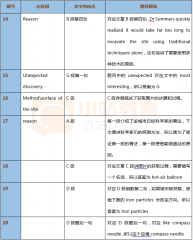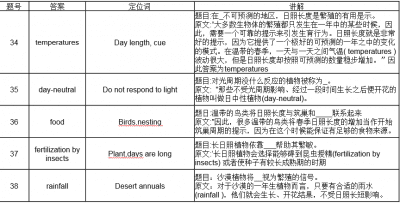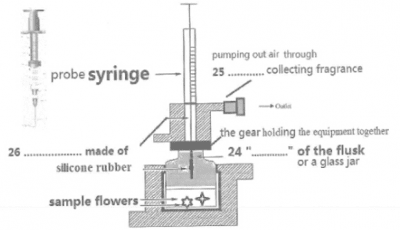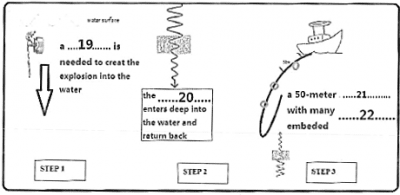雅思阅读找小标题类题型解题技巧
雅思阅读找小标题类题型解题技巧主要总结了雅思阅读中小标题类题型,即heading类题型的做题方法和技巧。这一类题型需要一定的做题技巧,具体的操作请参考文章。
雅思阅读找小标题类题型解题技巧
雅思阅读找小标题类题型解题技巧为大家带来雅思阅读中heading类题型,也就是找小标题类题型的题型要求,解题步骤和解题技巧。雅思阅读中找小标题类题目是54类常考题型的其中之一。本文将从找小标题类题型的定义和要求开始,再分析这种题的解题步骤和技巧。
Headings(找小标题)
1. 题型要求:文章由若干段话组成,要求给每段话找个小标题。
小标题即指该段话的段落大意,中心思想,主旨。本题型不是让你写出每段话的小标题,而是要求从选项列表(list of headings)中选择。
在现在的考试中,选项的数目往往大大多于文章中段落的数目,有很多干扰选项,假如文章有五段话,选项的数目很可能是十个,甚至十二个。
题目形式:通常会在文中一段话上标出小标题,然后要求为余下段落选择小标题。通常是原文的第一段。
在考试中,该题型A类每次必考一组,共5题左右。有时会考两组,共十题左右。G类不是每次必考,考的时候,一般只考一组,共五题左右。
2. 解题步骤
(1) 先将例子所在的选项从选项列表中划去,同时,不读例子所在的段落。
每个选项最多只能用一次,也就是说,两个段落的小标题不可能是一个选项。这是因为不同段落的主旨肯定是不同的,原文将他们分为不同的段落,就是要分别说不同的内容。
有时,这类题目的要求中有这样一句话:You may use any heading more than once(你可以使用任何小标题超过一次)。这句话纯属误导,也就是说,即使题目的要求中有这句话或类似的话,任何选项也不可能被使用两次以上。
既然每个选项最多只能用一次,所以例子所在的段落已经使用的选项是不会被其它段落使用的,将其划去,以免被其它的段落误选。而且在选其它段落的答案时,可以不看该选项,节省时间。
例子所在的段落已经给出了小标题,所以不必阅读该段落了,以免浪费时间,直接从下一段读起。
(2) 不要先看选项,而要从文章入手,读一段话,做一道题。
如果先看选项,不仅花费的时间很多,而且极易受到干扰选项的误导。所以先不要看选项,而是要先读文章。
读文章的时候,不要一下把文章全读完,而是读一段话,做一道题。假如原文的第一段已作为例子给出,那么,先读第二段,然后到选项列表中找该段话的小标题。然后再读第三段,同样处理,直至完成。这样做,不仅速度快,而且准确率高。
(3)读每段话时,要抓住该段话的主题句和核心词汇。正确答案常常是主题句的改写。
读每段话时,并不是该段落全要仔细阅读。这样,既浪费时间,也不容易抓住重点。应该抓住该段话的的主题句。
先读该段话的第一句,然后,与选项列表中大各选项一一对应,确定正确答案,正确选项一般就该句话的改写。如果答案不能确定,应再读该段话的第二句,然后,与选项列表中的各选项一一对应。如果答案还是不能确定,应再读该段话的最后一句,再与选项列表中大各选项一一对应。如果还是找不到正确答案,则就需要阅读整段话了。
根据统计,段落的主题句在第一句的可能性超过50%,段落的主题句在第二句的可能性超过20%,段落的主题句在最后一句的可能性超过20%。也就是说,按照上述方法做这种题型,读完该段话的第一句,就能在选项列表中找出该段话的Heading, 这种可能性超过50%。整段话都需要阅读的可能性不到10%。
(4) 某段话的答案确定后,将它的选项从选项列表中划去。
前面已经讲过,每个选项最多用一次,也就是说,不可能两个段落的小标题是一个选项。所以,一段话的答案确定后,将它的选项从选项列表中划去,以免被误选为其它段落的小标题。而且在选其它段落的答案时,可以不看选项,节省时间。但某段话的答案不太确定,如第三段可能是C,也可能不是C,这时不能将C从选项列表中划去。
3.解题技巧
(1)根据文章结构做Heading
由于雅思(A类)阅读以说明文和议论文为主,所以决定了文章的写作模式比较固定。通常会在文章的开头引出主题或提出论点,然后在中间段落进行实证或逻辑分析(按照时间推进,或者并列、递进等),在文章最后进行结论,或者提出对未来的展望。因此如果我们对文章的开头结尾段常用词汇熟悉,有的时候可以事半功倍。比如在The Impact of Wilderness Tourism 一文中:
Section A选iii(Fragile regions and the reasons for the expansion of tourism there)
Section B选V (disruptive effects)
Section C(论述应对措施)选ii (how … balance )
如果考生能及时发现备选项中的reason/ effects/ how…balance等词语就可以迅速定位各段的标题,而不需要深入每一段中细读。由此我们可以对文章每一部分常用词语做如下归纳:
若标题中出现 concept,explanation,definition,background,what is …problem等词,一般对应文章前面部分。
若标题中出现 summary, conclusion, results, effect, impact, consequence …等词,一般对应文章后面部分。
若标题中出现
表对比比较的词 compare,contrast,similar等;
表数据的词 data, statistics, census, figure, number等;
表百分比的词 rate, percentage, proportion等;
表金钱的词 cost, expense, budget等;
表假设的词 hypothesis, assumption 等;… …
一般对应文章中间部分。
(2)表转折总结等的关键词
当然很多时候备选项中并没有上面所说的关键字,我们则需要根据作者写作的逻辑关系来做题。其中又以表示转折和总结的关系词最为重要。因为如果转折词一出现,表明作者有新的内容提出来。关于but, however, although, even though, nevertheless/ despite the fact ….
As a result/as a consequence 、Sb.+ vt. (show/ suggest)…
等词语的论述已是老生常谈,关于这一考点在雅思阅读中的例子也是不胜枚举。笔者不再一一赘述。在这里重点谈论几个陷阱词。这是因为,这些词通常比较隐蔽,不容易引起大家的注意,比如剑桥七里面:
There is a widespread (陷阱词)belief that increasing wealth encourages people to live farther out where cars are the only viable transport. The example of European cities refutes(转折词) that. They are often wealthier than their American counterparts but have not generated the same level of car use. In Stockholm car use has actually fallen in recent years as the city has become larger and wealthier…
这段文字中,widespread就是一个陷阱词,它的后面出现了一个转折词refute, 但是由于refute 这个词语有的考生不认识,或者因为没有明显的转折的关系词而被忽略。另外常出现的陷阱词还有:
A. assume /assumption/ a widely held view/ (在段首时要引起注意,很可能是作者要驳斥的观点,要看作者是否同意之前的假定) 看后面有无转折词
B. Studies of… used to be based on archaeological and fossil evidence…..。A number of techniques ….since….,however, have….
C. It was once assumed that….
(3)通过抓主干快速做题
虽然有很多人,都在告诉考生雅思的主题句50%出现在段首,20%出现在第二句,20%出现在段尾。但是极个别情况下,此方法并不适用,如果一个段落中,段首段尾句和第二句都不能定位到Heading, 有没有明显的转折总结关系词,那么只能快速通读全文。比如:
A few months ago Kim Schaefer, sales representative of a major global pharmaceutical company, waked into a medical center in New York to bring information and free samples of her company’s latest products. That day she was lucky – a doctor was available to see her. The last rep offered me a trip to Florida. What do you have? The physician asked. He was only half joking.
在本段中,如果只读首尾句,是不可能得出文章的概要的。其关键部分恰恰在于倒数第2、3、4 句。所以这个时候就需要考生在平时就练就一个好的基本功---抓主干。只有这样才能遇事不慌,沉着应战。
NOTICE
(0)举例子的句子不会是主题句
(1)正确答案应是主题句的改写,所以与主题句特别一致的选项应引起怀疑。例:某段(1) 如果答案不确定,先将可能的选项全部选出。
(2) 干扰选项的特点是:段落中未展开说明的细节。
(3) 如果主题句比较复杂(如复合句),应重点看主句部分。主题句中,常常有如下的句式:Although/While/Despite/Despite the fact…, …的中文意思是:“虽然…,但是…”。前面是个让步状语从句,后面是主句,要说明的观点在主句中。
(4) 如果主题句中有show和suggest等词,应重点看其后的宾语从句。show和suggest是“表明”、“说明”的意思,其后的宾语从句往往是要说明的观点,是该段的主旨。
(5) 如果主句是not only…but also句型,应重点看but also后面的部分。not only…but also的意思是“不仅…而且…”,常用来承上启下。not only的后面是“承上”,即上一段主旨,but also 后面的部分是“启下”,即本段的主旨。所以重点看but also后面的部分。
(6) 问句不会是主题句问句通常作为引题,是过度性的句子。
(7) 如果需要阅读整个段落,应重点阅读该段落中的重点词句
A. 反复出现的词
B. 括号里的词
C. 引号里的词
D. 黑体字
E. 斜体字.
提高雅思阅读考试成绩三大诀窍
在我们进行雅思阅读考试或者在阅读英文文献的时候,我们需要把握的是文章中我们所需要的信息,我们将其称之为"核心信息",而其余的部分则与全文的理解或者解题没有直接的关系,属于"非必要信息",而我们阅读的主要目的是尽快挖掘出文章中的"核心信息",而对于"非必要信息",则不需要彻底和完整的理解,也即是所谓的"目的性阅读法"。
针对雅思阅读考试而言,所谓的"目的性阅读法"指的是在规定的时间内以最快的速度寻找到40道题目所针对的文章内容,然后对其内容进行判断以解题,因此,对于阅读考试来说,考生的任务可以分为两个步骤:"出题点的定位"和"相关信息的判断"。
STEP ONE "出题点的定位"
"出题点的定位"指的是通过寻找合适的定位词,判断题目相应考点在文章中对应的位置。而在这一过程中,最核心的技巧在于寻找到最合适的定位词,所谓最合适的定位词,简而言之,就是能够帮助考生以最快的速度定位到题目最精准的出题位置,从而直接进入下一个信息判断的步骤。
由此,我们不难看出,在"出题点的定位"这一步骤中,最关键的部分就在于如果判断题目中最容易定位和寻找的单词或短语,也就是定位词的判断。
STEP TWO 文章主要信息的把握
定位词判断完毕后,考生往往会面临的困扰是对于文章主要信息把握的必要性,常常会有考生提出"是否需要简单阅读文章"的问题,对于这一点,雅思专家给出的建议是"因地制宜",根据定位词特性做出不同的判断,如果考生在划定位词的过程中发现题目中涉及到特殊定位词的情况较多,那么根据已有的特殊定位词,并结合相关题型的顺序原则和阅读文章的"顺序"或"并列"式出题思路,考生完全可以不用把握每一段的信息来完成题目,那么,在这种情况下,阅读每一个段落就没有必要了;而另一种情况是,如果考生发现题目涉及特殊定位词的情况很少甚至几乎没有,而仅仅到文章中去盲目寻找普通定位词往往会耗费较长的时间,在这样的情况下,笔者建议考生可以阅读每一个段落的第一二句话,但要注意的是,考生不必强求读懂每一句话的意思,而重点应该放在寻找相关定位词的位置上,阅读段落首句的目的是希望能够获得某些题目的出题点,从而弥补特殊定位词较少带给考生的困难。
STEP THREE"相关信息的判断"
完成定位工作后,考生就需要开始对题目信息和稳重对应信息进行相关性的判断,这时候,往往需要考生进行同义反义词、和同义反义表达的分析,因此,在备考过程中,积累常考单词的同义和反义表达是必备的功课,也是获得阅读高分的关键。
之前我们已经提到,雅思阅读考试涉及的题型众多,不同的题型有不同的解题思路,那么所谓选择性解题的意义就在于如果我们可以合理的安排各种不同题型的解题顺序,是不是就可以一定程度上的减轻阅读压力和时间压力呢?
对于阅读中出现的题型,按照其难易程度做了如下的总结,★越多,则该题型相对更具难度。
雅思阅读考前必看文章之教育心理类
雅思阅读:Why so few university slots?
GETTING into college in America has gotten considerably more difficult over time. Zubin Jelvah writes:
Thanks to the positive effects of higher education on pay, the competition for entrance into the top colleges has increased sharply over the past three decades--particularly in the Northeast and California. But over the same period, the number of slots available at these schools has stayed largely unchanged, leading to a situation where demand far outstrips supply.
He says that this has led students to go to ever greater lengths to develop a competitive advantage in applying for university admission—taking advanced placement courses and test preparatory courses, and investing heavily in extracurricular activities. But that's a positive, right? Competition is forcing students to learn more and be more involved in the community.
To a certain extent, yes, but new research suggests that intense admissions competition also brings with it serious costs. Mr Jelvah cites a paper by John Bound and Brad Hershbein and says:
The researchers argue that instead of better preparing high school students for the rigors of higher ed, increased competition may actually be counterproductive. They find that increased competition is negatively correlated with college enrollment and earnings at age 25 for students in a subset of highly competitive states.
The authors themselves note:
In conjunction with the psychological and informational costs associated with competitive pressure ... these results should raise doubts that the increased competition for college admission has had a net positive effect on what and how students learn.
From an economic standpoint, it also seems probable that stagnant supply coupled with rising demand should generate a predictable price response. And sure enough:
That chart is from Niraj Choksi at the Atlantic. Now Claudia Goldin and Lawrence Katz have argued convincingly that recent growth in income inequality can be attributed to a relative decline in the supply of college graduates and a corresponding increase in the relative supply of lower skilled workers. But James Heckman has established that declines in college completion are about a drop in the rate of college enrolment and a corresponding decline in high school graduation rates. Here's the conclusion to a Vox piece by Mr Heckman and co- author Paul LaFontaine:
In the first half of the 20th century, growth in high school graduation was the driving force behind increased college enrolments. The decline in high school graduation since 1970 (for cohorts born after 1950) has flattened college attendance and completion rates as well as growth in the skill level of the U.S. workforce. To increase the skill levels of its future workforce, America needs to confront a large and growing dropout problem.The origins of this dropout problem have yet to be fully investigated. Evidence suggests a powerful role of the family in shaping educational and adult outcomes. A growing proportion of American children are being raised in disadvantaged families. This trend promises to reduce productivity and promote inequality in the America of tomorrow.
Mr Heckman tends to focus his policy solutions on the very young where, he has argued, remediation efforts bear the most fruit. At the same time, it's possible that the relative lack of success of remediation efforts later on in a student's career is directly related to the above state of affairs.
There is a wage premium earned by high school graduates relative to non- graduates, but its pretty small—much smaller than the gap between high school graduates and those with college degrees. The big advantage of a high school diploma is that it clears the way for a student to move on to the next level.
But the next level is increasingly out of reach for disadvantaged students. Money is occasionally the problem, but competition may be more of an issue. Disadvantaged households do not have the resources to invest in preparatory courses or multiple admissions applications. Students may not have the time after school to participate in extracurricular activities, needing, instead, to work. And disadvantaged students are unlikely to get the parental pressure at home to continue investing in activities designed to enhance competitiveness in admissions.
Perhaps the increasing competitiveness of college admissions processes are leading more students to conclude that college is out of reach—which is therefore reducing the return to a high school diploma and increasing the dropout rate.





